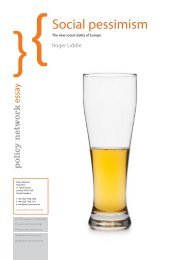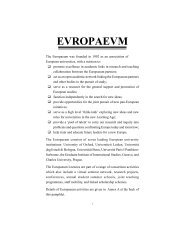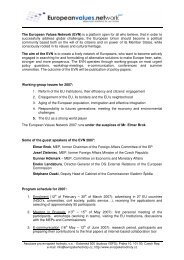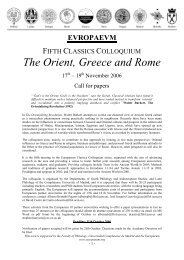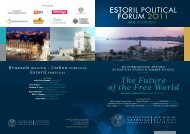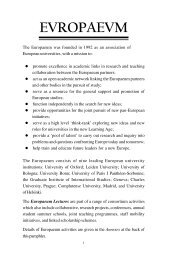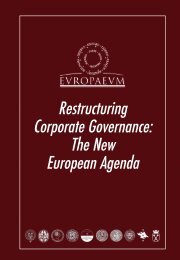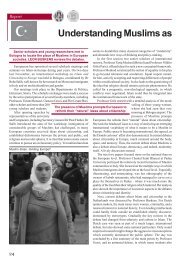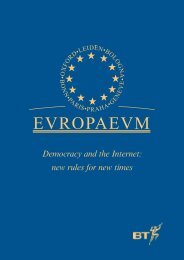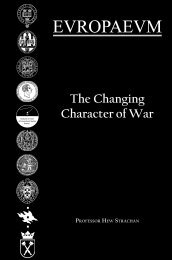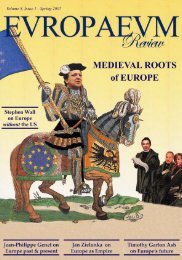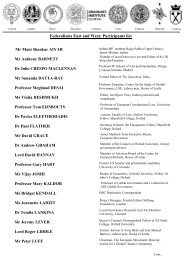The Medieval Origins of Constitutional ... - The Europaeum
The Medieval Origins of Constitutional ... - The Europaeum
The Medieval Origins of Constitutional ... - The Europaeum
You also want an ePaper? Increase the reach of your titles
YUMPU automatically turns print PDFs into web optimized ePapers that Google loves.
<strong>The</strong> <strong>Medieval</strong><strong>Origins</strong> <strong>of</strong><strong>Constitutional</strong>RepresentationPROFESSOR WIM BLOCKMANS
<strong>The</strong> <strong>Europaeum</strong> was founded in 1992 as an association <strong>of</strong>European universities, with a mission to:• promote excellence in academic links in research and teachingcollaboration between the <strong>Europaeum</strong> partners;• act as an open academic network linking the <strong>Europaeum</strong> partnersand other bodies in the pursuit <strong>of</strong> study;• serve as a resource for the general support and promotion <strong>of</strong>European studies;• function independently in the search for new ideas;• provide opportunities for the joint pursuit <strong>of</strong> new pan-Europeaninitiatives;• serve as a high level ‘think-tank’ exploring new ideas and newroles for universities in the new Learning Age;• provide a ‘pool <strong>of</strong> talent’ to carry out research and inquiry intoproblems and questions confronting Europe today and tomorrow;• help train and educate future leaders for a new Europe.<strong>The</strong> <strong>Europaeum</strong> consists <strong>of</strong> 10 leading European universityinstitutions: University <strong>of</strong> Oxford; Leiden University; University <strong>of</strong>Bologna; University <strong>of</strong> Bonn; University <strong>of</strong> Paris I Panthéon-Sorbonne;the Graduate Institute <strong>of</strong> International Studies (HEI), Geneva; CharlesUniversity, Prague; Complutense University, Madrid; University<strong>of</strong> Helsinki, and Jagiellonian University, Krakow.<strong>Europaeum</strong> Lectures are part <strong>of</strong> a range <strong>of</strong> consortium activities whichalso include collaborative research projects, conferences, annual studentsummer schools, joint teaching programmes, staff mobility initiatives,and linked scholarship schemes.Details <strong>of</strong> <strong>Europaeum</strong> activities are given in the Annexes at the back <strong>of</strong>this pamphlet.
A EUROPAEUM LECTUREDELIVERED ATTHE UNIVERSITY OF OXFORDON13TH FEBRUARY 2007<strong>The</strong> <strong>Medieval</strong> <strong>Origins</strong> <strong>of</strong><strong>Constitutional</strong> RepresentationWIM BLOCKMANSPr<strong>of</strong>essor <strong>of</strong> <strong>Medieval</strong> HistoryUniversiteit LeidenEUROPAEUM LECTUREin association with theMODERN EUROPEAN HISTORY RESEARCH CENTREFACULTY OF HISTORY, UNIVERSITY OF OXFORD
PROFESSOR WIM BLOCKMANSPr<strong>of</strong>essor Wim Blockmans studied History atthe University <strong>of</strong> Ghent where he obtained hisPhD (cum laude) in 1973. He continued to workat the University <strong>of</strong> Ghent as senior assistantuntil 1975. In 1974, he also took on the post <strong>of</strong>Reader in History at the Provincial Institute forTranslators and Interpreters in Ghent, whichhe continued to do until 1988, even after hetook up a post in the Netherlands in 1975.In 1975, he took the opportunity to work as ahistorian among social scientists as Reader in Social and Political Historyin the Faculty <strong>of</strong> Social Sciences at the Erasmus University inRotterdam. This led to a pr<strong>of</strong>essorship in 1980. From 1980 to 1989 hewas also Dean <strong>of</strong> that same Faculty.By 1987, the time was right to move closer to the centre <strong>of</strong> historicalresearch and education, and he moved to Leiden as Pr<strong>of</strong>essor <strong>of</strong><strong>Medieval</strong> History. During this period he supervised over 35 PhDstudents. Nevertheless, the social sciences still continued to hold anattraction and he was also in charge <strong>of</strong> Contemporary European Historyin the Leiden Faculty <strong>of</strong> Social Sciences from 1993 to 2000.Since 2002, Wim Blockmans has held the post <strong>of</strong> Rector <strong>of</strong> theNetherlands Institute for Advanced Study in the Humanities and theSocial Sciences. In this capacity, he supervises the academicprogramme, the selection <strong>of</strong> fellows, and daily running <strong>of</strong> this institute.2
ContentsA note on Wim Blockmans....................................................2<strong>The</strong> <strong>Medieval</strong> <strong>Origins</strong> <strong>of</strong> <strong>Constitutional</strong> Representation............5References.........................................................................28Annex A : <strong>The</strong> <strong>Europaeum</strong> Record....................................30Annex B : <strong>The</strong> <strong>Europaeum</strong> Partners..................................33Annex C : <strong>The</strong> <strong>Europaeum</strong> Lectures..................................35Published by the <strong>Europaeum</strong>, Oxford, 2008© 2008 <strong>Europaeum</strong> / Wim BlockmansRegistered Charity No: 11054773
This essay was originally prepared as alecture given at the University <strong>of</strong> Oxford onFebruary 13, 2007 in association with theEuropean Modern History Research Centre,and as part <strong>of</strong> the <strong>Europaeum</strong> MAProgramme in European History andCivilisation, linking Leiden University, ParisI-Sorbonne, and the University <strong>of</strong> Oxford.4
<strong>The</strong> <strong>Medieval</strong> <strong>Origins</strong> <strong>of</strong><strong>Constitutional</strong> RepresentationParliamentary democracy, beyond any doubt, is one <strong>of</strong> Europe’sfundamental contributions to universal history. Wars have recently beenfought, and still are being fought in the Middle East, in the belief thatthis will create stable democracies there. In recent years, democracyhas become the hallmark for a State to be accepted into internationalor supranational organizations, such as the EU, at least at the level <strong>of</strong>political discourse. <strong>The</strong> admission, in the 1980s, <strong>of</strong> countries with aproblematic record <strong>of</strong> democratic traditions, such as Portugal, Spainand Greece, is said to have encouraged the development <strong>of</strong> newinstitutional arrangements there. EU candidates are screened using thecriterion <strong>of</strong> whether there is a well-established democratic system <strong>of</strong>political parties, free elections and the rule <strong>of</strong> law. Advocates <strong>of</strong> theadmission <strong>of</strong> Turkey, Serbia and Albania argue that their inclusion inthe Union will support the development <strong>of</strong> more democratic rule inthese countries and counterbalance strong authoritarian local traditions.Time and again, however, the introduction <strong>of</strong> democracy, as developedin Western Europe over the centuries, has proved to be easier on thepaper <strong>of</strong> constitutions than in political practice. Some social structures,such as those based on clans or tribes, simply do not fit within theWestern model <strong>of</strong> democracy. In his famous book Social <strong>Origins</strong> <strong>of</strong>Dictatorship and Democracy, first published in 1966, BarringtonMoore compared the social conditions for the rise <strong>of</strong> dictatorial regimesin various states with those for the growth <strong>of</strong> parliamentary systems.He focused on the class structure <strong>of</strong> societies, and especially on the5
Wim Blockmansposition <strong>of</strong> peasants and the middle classes. In his view, it was thebourgeoisie which typically pushed for constitutional rights and politicalparticipation. His famous statement ‘no bourgeoisie, no democracy’still seems to express an essential truth.Recent scholarship has delved deeper into social structures at a moreindividual level. <strong>The</strong> collective studies produced <strong>of</strong> the biographies <strong>of</strong>the powerful elites have made it possible to identify the behaviouraland career patterns <strong>of</strong> <strong>of</strong>fice-holders, and to trace their personalrelations. Networks have been analysed and this new research hasadded flesh to the bones <strong>of</strong> structural analyses <strong>of</strong> the social classes.Moreover, we now also have the so-called linguistic turn by whichpolitical history can be rewritten in terms <strong>of</strong> discourse analysis. Thisapproach has the merit <strong>of</strong> bridging the huge gap which traditionallyexisted between intellectual historians studying learned political theoryand those trying to understand the role <strong>of</strong> ideas in political strife. Modernpolitical history is now more about collective memory, communicationand interaction, and the divisions between the social classes now appearless clear-cut and, perhaps, even less relevant than they were believedto be in the 1960s and 1970s.In this lecture, I will address the circumstances and conditions underwhich the fundaments <strong>of</strong> constitutionalism and representation emergedin Western Europe. I will connect these insights with some observationsabout the transition towards democratic rule in Central and East Europein the present days.<strong>The</strong> Slow TransitionEarly February 2007, the former President Putin found it necessary toannounce via a press conference that Russia is not using its energyresources as a political weapon and that it wants to be seen as a reliablegas supplier. On the same occasion, he again declared that Russia was6
<strong>Constitutional</strong> Representationnot implied in the murder <strong>of</strong> Alexander Litvinenko, arguing that thevictim had no access to state secrets. This could be interpreted assignifying that someone with knowledge about such secrets is indeedconsidered a legitimate target. Nevertheless, the affair echoed thepuzzling health problems <strong>of</strong> the former opposition leader and currentpresident <strong>of</strong> Ukraine Victor Yushchenko. <strong>The</strong> European Court forHuman Rights has issued numerous condemnations <strong>of</strong> Russia’s violations<strong>of</strong> human rights in Georgia and Chechenya, to which Russian authoritiescomplained that the Court is ‘prejudiced and politically guided’. Russiais not the only superpower that dislikes the international Courts <strong>of</strong> Justice,even though these vital institutions guarantee the rule <strong>of</strong> a law acrossthe globe. Princeps legibus solutus, the ruler is not bound by the law,says a famous dictum in Roman Law dating from the late Empire. Thissuccession <strong>of</strong> painful incidents seems less related to the formal question<strong>of</strong> Putin’s role as elected president or whether Russia has a democraticparliament with political parties, than is to do with a certain style <strong>of</strong>government, jurisdiction, a public discourse and a political culture thatmay be typical <strong>of</strong> a particular country.Similar concerns can be expressed about the political culture <strong>of</strong> severalcountries <strong>of</strong> Central and Eastern Europe. Just taking a look at some <strong>of</strong>the newest EU-member-states, I can point to the allegations <strong>of</strong>widespread corruption in Bulgaria and Rumania. In order to meet someobjections from the EU before the admission in January 2007, theRumanian Parliament set up a National Integrity Agency in order toinvestigate the origin <strong>of</strong> the properties <strong>of</strong> ministers and MPs. FormerPrime-Minister Nastase and the president <strong>of</strong> Rompetrol have alreadybeen subjected to investigation. However, on 13 February, the Senatepassed a no-confidence vote against the Minister <strong>of</strong> Justice who wasin charge <strong>of</strong> this investigation. President Basescu supported the ministerand criticised the Senate for its encouragement <strong>of</strong> ‘a masked system<strong>of</strong> corruption’.7
Wim Blockmans<strong>The</strong> harsh antagonism between a monster coalition <strong>of</strong> ultra-nationalists,social-democrats, the Hungarian minority party, and even the governingliberal party in Parliament, and the President led to a procedure <strong>of</strong>impeachment. <strong>The</strong> President’s advocates said that his opponents weretrying to resist his reform priorities; the struggle against corruption, theopening <strong>of</strong> the Securitate-archives and the general condemnation <strong>of</strong>the communist regime. In a speech in Parliament, he announced himselfa referendum about the reform <strong>of</strong> the election system, which he says itdoesn’t give the voters any influence on the persons to be elected onany particular list. He claims that this leads to the influence businesspeople have on representatives. In July 2008, the third half-yearly reporton the measures taken in Rumania and Bulgaria against corruption andcriminality led the EU Commission to block 521 million subsidies to thelatter country. <strong>The</strong> Commission also heavily criticised ‘the vulnerability’<strong>of</strong> Rumania’s judiciary and the ‘strong political interference’ with thepolicy against corruption.Corruption had thus become a concrete measure to check and sanctionthe compliance <strong>of</strong> new member states to the EU standards. However,corruption is not necessarily and not uniquely a problem <strong>of</strong> states Centraland Eastern Europe. <strong>The</strong> Corruption Perception Index <strong>of</strong> therenowned Transparency International institute in Berlin showed for2007 very positive indicators for Estonia and Slovenia, while no lessthan twelve <strong>of</strong> the twenty-seven EU-members were rated below thesufficiency-level. Among them, Italy, scoring 5.2 on a scale <strong>of</strong> 10, aslow as the Czech Republic, and not much higher than Greece (4.6),Poland (4.2), Bulgaria (4.1) and Rumania (3.7). As the latest admitted,Bulgaria and Rumania have been submitted to draconian controls, whilethe problem is not significantly less evident in Poland. And what tothink about the standards which are not met by old EU-members suchas Italy and Greece, but to whom no sanctions can be imposed?8
<strong>Constitutional</strong> RepresentationEven trickier is the question how to assess the respect <strong>of</strong> democraticrules. Here, party democracy and parliamentary control seem to takeroot with some difficulty. In the Czech Republic negotiations for theformation <strong>of</strong> a government were blocked for six months in 2006, becausethe main parties could not reach a compromise. Hungary experienceda storm <strong>of</strong> protest and mass demonstrations after the publication <strong>of</strong> theprime minister’s speech about how he lied in public about the statefinances in order to win the elections in April 2006. His predecessorMedgyessy had to step down after publications about his activities inthe secret service under the communist regime. In February 2007, thepolarisation in the country had all but diminished; the opposition claimedthat a new Iron Curtain had been built around the Parliament building –literally as well as metaphorically. <strong>The</strong> leaders <strong>of</strong> the two political blockskeep each other in an impossible balance. <strong>The</strong> political discourse ispoisoned but lacks content. <strong>The</strong> ruling socialist party may have to beblamed, but the opposition doesn’t <strong>of</strong>fer an alternative policy and insteadholds an ultra-nationalistic discourse addressing the millions <strong>of</strong>Hungarians beyond the state’s borders.In Poland, nine ministers stepped down in 15 months; in 2007, theKaczynski brothers prepared a law by which the members <strong>of</strong> the MilitaryCouncil who ruled the country after the coup in 1981 would be degradedand lose their pensions. This is seen by the opposition as an act <strong>of</strong>political revenge against those who courageously acted to prevent aRussian invasion similar to those in Prague 1968 and Budapest 1956.<strong>The</strong> problem is more complex than the fate <strong>of</strong> a handful <strong>of</strong> militaryjunta members. As the resignation <strong>of</strong> Archbishop Wielgus in January2007 shows, the transition from an authoritarian towards a democraticregime necessitates public debate about the role <strong>of</strong> all those involved inthe former system. A report commissioned by the Kaczynski brotherswho had campaigned under the motto <strong>of</strong> a ‘moral revolution’ by whichthey would clear the country <strong>of</strong> the communists’ lasting control, failed9
Wim Blockmansto demonstrate such a continuity, and lost its authority after thepublication <strong>of</strong> the removal <strong>of</strong> the prime minister’s name. A positivesignal has been Prime Minister Kaczynski’s defeat in the 2007 electionand the dismissal <strong>of</strong> his projected legislation, which has been declaredanti-constitutional. Nevertheless, the controversies and the frequentpolitical re-orientations remain.As in Poland, the Orthodox Churches have also been criticised fortheir role under the communist regime. In Rumania, a presidentialcommittee <strong>of</strong> historians in December 2006 published a report on themisdeeds perpetrated by the communist regime. <strong>The</strong> report’s critique<strong>of</strong> the church was vehemently refuted by the patriarch who announcedan ‘objective’ investigation. A similar initiative was taken by Slovakia’scatholic bishops’ conference after allegations <strong>of</strong> the archbishop’s activityfor the secret service between 1972 and 1989. Here the church’scollaboration with the Nazi-regime would also be investigated.<strong>The</strong> German unification <strong>of</strong> 1989 was immediately followed by thescreening <strong>of</strong> all leading <strong>of</strong>fice-holders and was accompanied by theopening <strong>of</strong> all the archives <strong>of</strong> the Stasi secret police, just as the Naziarchives had been opened in 1945. This helped Germany to come toterms with its complicated past in a transparent and civilised manner.In Rumania, the Securitate archives were not opened until 2005, whichled to recriminations in the media by political opponents. In thevehemence <strong>of</strong> the antagonisms, archives are <strong>of</strong>ten abused as politicalinstruments. In proportion to the population, Securitate employed fortytimes as many informers than the Hungarian secret service. <strong>The</strong> opening<strong>of</strong> Hungarian secret archives in 2003, which was triggered byrevelations about former Prime Minister Medgyessy’s past as aninformer, has not yet been regulated by a general rule. No overallcondemnation <strong>of</strong> <strong>of</strong>ficials in the communist regime has yet been issued.In February 2007, a court had to decide about the access <strong>of</strong> a journalistto the files <strong>of</strong> six religious leaders, on the basis that they had played a10
<strong>Constitutional</strong> Representationpublic role. As a consequence, a debate arose about the authenticityand significance <strong>of</strong> historical documents in general. This is reasonable,as the accuracy <strong>of</strong> a secret report is obviously influenced by the spy’smotives, which may be ideological, financial or for blackmail.Eighteen years after the great transition <strong>of</strong> Central Europe, the politicalculture seems characterised by disappointment following exaggeratedhopes, uncertainty about the future, repeated radical reorientations,heated accusations, and violent conflicts. <strong>The</strong> political culture is stillweighed down with the remnants and recollections <strong>of</strong> previous regimes,especially since the archives were kept locked for far too long as therewere so many who had an interest in burying the past. This atmosphereundermines trust in the authority <strong>of</strong> newly established institutions. Onthe other hand, hopeful developments are to be noted in several countries,which should warn us against manicheistic thinking about ‘West’ and‘East’. In some countries, democracy and its values are taking rootsfaster than in others; and, even in older democracies, stability cannotbe taken for granted.Do these observations lead to the conclusion that, eighteen years afterthe fall <strong>of</strong> the Berlin wall and the Iron Curtain, Europe is still a dividedcontinent in which the West sets the tone and the remainder will remainthe periphery forever? <strong>The</strong> free labour market is now attracting skilledas well as seasonal workers to the West: most <strong>of</strong> us have heard <strong>of</strong> thefamed Polish plumbers. At the same time, labour-intensive industriessuch as automobile factories are moving eastward because productioncosts in the West are no longer competitive on the global market. Renaultand Volkswagen closed down factories in Brussels to build new ones inPoland. This is the commonly known rationale <strong>of</strong> the free marketeconomy. However, in this logic, those on the periphery remaindependent, even if there has been impressive economic growth in spite<strong>of</strong> all the disruptions. <strong>The</strong> Western rich life-style now approaches closerthan ever: it is flaunted by the nouveaux-riches, displayed in extravagant11
Wim Blockmansnew luxury shops and brought into the home via imported televisionprogrammes – another feature <strong>of</strong> Western domination. This fostersrising expectations while incomes lag way behind. <strong>The</strong> immense socialand economic problems place even more pressure on the disrupted anddistorted political system.Variety <strong>of</strong> <strong>Medieval</strong> Representation<strong>The</strong> discrepancy we observe today between the economic and politicaldevelopments <strong>of</strong> Western and Central Europe is not new. If we considerpolitical representation and constitutionalism as being a unique creation<strong>of</strong> medieval Europe, it is essential first to understand the conditions thatproduced these political phenomena; and second, to elucidate theconditions that gave rise to the huge variety <strong>of</strong> representative institutions.My underlying question is whether or not the conditions for theemergence <strong>of</strong> parliamentarism have been weak or lacking in Centraland East Europe since the very beginning.In an influential article published in 1931, the German historian OttoHintze identified the conditions necessary for the unique emergence <strong>of</strong>representative government in Western Europe. 1 In his view, politicaland social life in the West was moulded by the twin systems <strong>of</strong> feudalismand the Christian Church. <strong>The</strong> high clergy, the only intellectualscontrolling the chanceries <strong>of</strong> the emerging states, could oppose limitationsto lay authority by referring to general rules <strong>of</strong> Christian ethic. Germaniclaw, especially as it was formalized in feudalism, <strong>of</strong>fered a secondlimitation to rule in its concept <strong>of</strong> reciprocal power relations. A rulerwas always bound by mutual obligations and could be held to respectcertain moral and legal standards. In particular, the immunity <strong>of</strong>ecclesiastical institutions, clergy, and the inhabitants <strong>of</strong> lordships andcities formed the basis <strong>of</strong> the subjective public rights <strong>of</strong> privileged groups.Western states did not grow into a unified empire but constituted weaklyintegrated parts <strong>of</strong> a loose global system which shared Christian values,12
<strong>Constitutional</strong> Representationrepresented by a universal and independent Church. <strong>The</strong> constantcompetition between states led to an intensification and a rationalization<strong>of</strong> state systems; rulers sought the active support <strong>of</strong> their citizens in themobilization <strong>of</strong> resources needed in the growing competition. <strong>The</strong>ecclesiastical model <strong>of</strong> conciliar representation was easily transferredto secular circumstances.Hintze saw the extension <strong>of</strong> monarchical authority over therepresentative institutions as a necessary condition for the development<strong>of</strong> representation: in his view ‘municipal structures everywhere excludedrepresentation by estates’. On the other hand, unlimited feudalism tendedto dissolve the emerging states. In his view, representative institutionscould only develop and last within centralizing states.It is generally assumed that states or, before their stabilization, countriesor territories, formed the system in which representative institutionsoperated. Hintze regarded the nature <strong>of</strong> a monarchical state -competitive, centralizing and rationalizing, - as a necessary conditionfor the full development <strong>of</strong> a Ständestaat. This concept, difficult totranslate into English, refers to a state in which the estates have aconstitutional political role. In this perspective German historiographyadopted the view <strong>of</strong> a dualistic system <strong>of</strong> the (territorial) prince and theestates. Even the opinion <strong>of</strong> Peter Moraw holds that ‘the prince and hiscourt were not only the point <strong>of</strong> departure and antagonist <strong>of</strong> the system<strong>of</strong> estates, but the nodal point from which the fundamental development<strong>of</strong> the territories has to be understood.’ 2 Although this viewpoint maybe adequate for large parts <strong>of</strong> continental Europe, it certainly does notfit urbanized coastal areas, where territorial and monarchical stateshad much less influence. It can certainly not be considered a generalrule that the monarch was the initiator and sole focus <strong>of</strong> representativeactivities, not even in the Empire. In some urban areas, other types <strong>of</strong>representation developed into regional urban leagues; in some <strong>of</strong> theseassociations <strong>of</strong> cities (Einungen or hermandades) or Landfrieden13
Wim Blockmans(territorial peace treaties) princes and nobles were included as well.Such systems could develop only thanks to negotiations and some form<strong>of</strong> representation. Regional urban leagues found unity in the GermanHanse, which German historiography, in my view incorrectly, does notconsider as another type <strong>of</strong> representative system. <strong>The</strong> Hanse citieshad their own representative assemblies on different levels and actedtowards the outside world in the name <strong>of</strong> their member towns. In asimilar way, groups <strong>of</strong> coastal towns created regular contacts with otherauthorities in support <strong>of</strong> their citizens’ trade. From the consulado delmar <strong>of</strong> Barcelona, dating from 1258, to the more conventionalparticipation in the sealing <strong>of</strong> commercial treaties struck between princes,such as that carried out by Flemish cities during the thirteenth century,we can observe many examples <strong>of</strong> urban representatives operating innetworks very different from those <strong>of</strong> the territorial state and its monarch.Apart from the networks <strong>of</strong> commercial cities, communities <strong>of</strong> freepeasants in particular <strong>of</strong> cattle breeders proved able to represent theirinterests on their own initiative before trading partners or politicalcompetitors. 3Inspiring as it may be, I think Hintze’s vision on the necessity <strong>of</strong>monarchical centralization for the development <strong>of</strong> representation hasto be rejected. In my view, communes could very well create stablerepresentative systems which deal with a good deal <strong>of</strong> publicadministration. On the other hand, it is evident from the early modernhistory <strong>of</strong> all Western monarchies that the kings tried to rule withouttheir Parliament, States General, Rikstag or Cortes as soon and asmuch as they could, as soon as they had secured regular income withouttheir subjects’ consent. 4 Empirical data unknown to Hintze has sincedemonstrated that in Europe’s most densely urbanized regions, tradingcities spontaneously created various forms <strong>of</strong> consultation and problemsolvingbetween each other, in order to support their economic relations.<strong>The</strong>se areas were mainly located on the coasts or along the great rivers,where the bulk cargos could be transported that were needed to sustain14
<strong>Constitutional</strong> Representationthe large urban populations. In those cases where a city grew muchmore than all its neighbours, because <strong>of</strong> its strategic location, it functionedas a gateway and imposed its rule upon smaller towns and marketplaces. If no monarch could effectively impose his sovereignty oversuch a metropolis, it colonized its hinterland, near as well as far away,as was the case in Venice and Genoa. <strong>The</strong> relationship <strong>of</strong> dominationexcluded representation on the basis <strong>of</strong> autonomy. This is probably themodel Hintze had in mind when the stated that ‘municipal structureseverywhere excluded representation by estates’. So, neither monarchsnor cities guaranteed on their own the emergence <strong>of</strong> constitutionalrepresentation. 5However, there were also highly urbanized regions with a more evenlyspread urban hierarchy and where countervailing powers such asmonarchs, aristocratic and ecclesiastical landowners were influential.In such regions, a division <strong>of</strong> power had to be reached on the basis <strong>of</strong>negotiation. <strong>The</strong>re, conflicts <strong>of</strong> interest between the various power elitesled to intensive bargaining in assemblies which were composed <strong>of</strong> awide variety <strong>of</strong> members, including all the powers that be. Muchdepended on their relative impact, which was likely to shift over time.We should try to identify the specific strengths and weaknesses foreach <strong>of</strong> the contenders:- for monarchies: dynastic continuity, personal competence,availability <strong>of</strong> independent resources;- for great landowners: size and yield <strong>of</strong> the properties, theirconcentration, marketable yields, extent <strong>of</strong> the seigniorial rights;public power through <strong>of</strong>fices held, personal networks at court andin the Church;- for cities: their position in the urban hierarchy and in interregionalnetworks (expressing population size, market position, location),inter-urban cohesion, stability <strong>of</strong> internal social relations.15
Wim BlockmansThis mixed model can be observed in Catalonia and Valencia, in thecoastal provinces <strong>of</strong> the Low Countries, Northern Germany (the Hanse)and Eastern Prussia along the Vistula. <strong>The</strong>se well-developed and fairlyautonomous municipalities had exclusive powers in matters related totheir maritime trade. Since the mid-thirteenth century, Barcelona andValencia had their own consulates <strong>of</strong> the sea, justices who sentencedcases with an extra-territorial character on the basis <strong>of</strong> a special lawcode, developed out <strong>of</strong> practice. <strong>The</strong>ir flourishing trade gave these citiesa strong bargaining position vis-à-vis the King <strong>of</strong> Aragon and thearistocracy.In a similar way, other special jurisdictions developed under the control<strong>of</strong> major cities. To ensure their survival, the large cities indeed neededto control their direct environment, where their wealthy burghers investedin intensive husbandry and cattle-raising. Citizens needed to be sure <strong>of</strong>a supply <strong>of</strong> food, drinkable water, and raw materials. <strong>The</strong>refore, thecities imposed their rule on their direct hinterland. A typical example isthe control <strong>of</strong> the water supply and irrigation as seen in Southern Europe.Since the medieval epoch, the Water Tribunal has met every Thursdaymorning at the North Gate <strong>of</strong> the Cathedral <strong>of</strong> Valencia, and orally alldisputes concerning irrigation are settled. <strong>The</strong> irrigation network in theHuerta dates back to Roman times and was greatly extended andimproved under Moorish rule. Until today, it enables the yield <strong>of</strong> severalharvests per year in this fertile alluvial plain.Similarly, the drainage <strong>of</strong> marshy lands in Northwest Europe wasorganized by landholders, many <strong>of</strong> whom were burghers. <strong>The</strong>maintenance <strong>of</strong> the increasingly complex system <strong>of</strong> canals, dams, dykes,sluices and windmills, and the jurisdiction in these matters <strong>of</strong> vital interest,required technical expertise. This knowledge developed as a result <strong>of</strong>practical necessity and grew incrementally among the people directlyinvolved. <strong>The</strong> solidarity and loyalty <strong>of</strong> all inhabitants could only be obtainedby allowing their direct participation in decision-making and by a rigorous16
<strong>Constitutional</strong> Representationdistribution <strong>of</strong> all charges over the owners as well as the holders <strong>of</strong> theland, in proportion to the surface protected by the system. Strict controlon the application <strong>of</strong> the required measures and harsh justice in case <strong>of</strong>neglect was required to secure the survival <strong>of</strong> entire communities andtheir property. 6Specific forms <strong>of</strong> public authority thus grew out <strong>of</strong> necessity on theinitiative <strong>of</strong> the burghers and peasants themselves who had a clearunderstanding <strong>of</strong> their needs and interests. In some regions suchorganizations were concerned with the regulation and jurisdiction <strong>of</strong>maritime trade, elsewhere it concerned irrigation or drainage, elsewhereit was the transport over the passes in the Alps or the transhumance<strong>of</strong> the herds <strong>of</strong> millions <strong>of</strong> sheep, as in the Castilian mesta. All thesesituations required knowledge which only the people involved couldprovide; their practices led to the creation <strong>of</strong> special codes <strong>of</strong> law. <strong>The</strong>Monarchies had hardly anything to do with such matters, which <strong>of</strong>tentransgressed their own territorial powers. If they did have a role it waslimited to the formal recognition and publication <strong>of</strong> regulations elaboratedby the representatives <strong>of</strong> the communities.In regions where urban and rural communities formed representativeinstitutions, these could intervene collectively in political issues in orderto protect their common interests. <strong>The</strong> weakness <strong>of</strong> monarchical power,such as during a under age, was a typical opportunity for the cities toclaim control over the state. In thirteenth-century Flanders, the majorcities played a role as a collective body. <strong>The</strong>y are mentioned as earlyas 1209 as the ‘six cities’ in an act <strong>of</strong> King John <strong>of</strong> England concerningLa Rochelle. In 1213, as a league, they struck a treaty with the king,which showed their ability to act autonomously in their relations with aforeign region which they had close commercial ties. From 1241,documents call them the scabini Flandriae, an acknowledgement <strong>of</strong>the collective action <strong>of</strong> the administrators either in relation to judicialconflicts between themselves or disputes in which only one was involved,17
Wim Blockmansand over matters such as trade fairs and the control <strong>of</strong> the currency. Inall these matters, the countess acted only ‘with the assent <strong>of</strong> thealdermen <strong>of</strong> [the major cities <strong>of</strong>] Flanders’. During the most activeperiod, in the first half <strong>of</strong> the fifteenth century, the ‘Four Members’attended between 350 and 450 meetings per year, <strong>of</strong>ten in parallelsessions, sometimes at different places and with missions abroad. Withinthe county, their meetings lasted normally four to six days. <strong>The</strong>semeetings were largely informal, normally involving ten to fifteenparticipants who were the main initiators. Long tradition and thecontinuingly strong demographic and economic position <strong>of</strong> the ‘FourMembers’ meant that their domination <strong>of</strong> the representative systemwas accepted, both by the smaller communes and by the counts <strong>of</strong>Flanders.In the cities, meetings <strong>of</strong> large councils including deputies <strong>of</strong> the crafts,and, in the rural districts assemblies <strong>of</strong> freeholders had the last word ontaxation. Participation by guilds in the administration was nowhere asadvanced as in Ghent between 1370 and 1540, when twenty out <strong>of</strong>twenty-six aldermen were elected annually by and from the crafts.Until the middle <strong>of</strong> the fifteenth century the main concerns <strong>of</strong> the ‘FourMembers’ were trade regulations, commercial litigation, coinage, fiscalpolicy and foreign relations. Later, taxation and defence were to becomethe major interests. Assemblies <strong>of</strong> three estates were created by thecount as late as 1400, but these met much less frequently than did the‘Four Members’ who dominated them. Towards the end <strong>of</strong> the fifteenthcentury, however, the meetings <strong>of</strong> Estates and <strong>of</strong> the States Generalbecame more influential, as the government preferred collaborationwith these more conservative bodies. 7When King Louis VIII <strong>of</strong> France took possession <strong>of</strong> Languedoc in1226, after the so-called crusade against the heretics, he took care todemand oaths <strong>of</strong> fealty from all the prelates, nobles and cities in theregion. His commissioners travelled around to receive these oaths, sworn18
<strong>Constitutional</strong> Representationboth privately and in public assemblies where the consuls and othertownsmen represented their communes. <strong>The</strong> transfer <strong>of</strong> the county <strong>of</strong>Toulouse to King Alfonso IX <strong>of</strong> Leon was formalized in 1249 in a series<strong>of</strong> assemblies in which different sectors <strong>of</strong> the territory rendered theiroaths. <strong>The</strong> townsmen <strong>of</strong> Toulouse did so and heard their libertiesconfirmed. In Agen, the assembly ‘composed <strong>of</strong> barons and knights <strong>of</strong>the diocese, consuls <strong>of</strong> Agen, and councils and burghers <strong>of</strong> regionalburghs, castra, and villages’ refused to comply with the request <strong>of</strong> thecommissioners to swear fealty, referring to their liberties and customsand to conflicting rights to the throne.Indeed, in 1279 an assembly <strong>of</strong> prelates, deputies <strong>of</strong> the chapters, barons,knights, nobles, deputies <strong>of</strong> towns and villages was summoned to transferthe lordship to the proctor <strong>of</strong> King Edward I <strong>of</strong> England, who securedfeudal recognition in person in 1286 in a general assembly as well as inlocal meetings. <strong>The</strong> whole episode shows the necessity for kings toobtain the assent <strong>of</strong> their new subjects in the form <strong>of</strong> regional assemblieswhich had their own rights which they clearly wanted to have respected.Cities and towns in the regions <strong>of</strong> Languedoc met on the initiative <strong>of</strong>royal <strong>of</strong>ficers as well as on their own to legislate on the export <strong>of</strong> grain(1269-75) and on coinage (1212 with the nobility, in 1292 alone), tocollect petitions, to regulate trade routes, to press a suit against theEnglish ‘great custom’ on the Garonne (1285) and against the bishop <strong>of</strong>Cahors in relation to usury.<strong>The</strong> towns <strong>of</strong> Castile from 1282 onwards regularly formedhermandades. <strong>The</strong>se autonomous associations, independent from theking’s summons, were set up to preserve their privileges, and ifnecessary to protect against the king. <strong>The</strong>ir movement went far beyondtaking positions during the disputes for royal power. <strong>The</strong> towns’associations in fact formed the vanguard in the cortes, which duringthe minority from 1295 to 1301 claimed a place in the royal householdand chancery, as well as a role in the collection <strong>of</strong> taxes and the custody19
Wim Blockmans<strong>of</strong> royal castles. In 1312, a hermandad <strong>of</strong> some towns in León calledfor the education <strong>of</strong> the young king to be placed in the hands <strong>of</strong> goodcitizens, they objected to unlawful taxation and the alienation <strong>of</strong> royalcastles and cities. Moreover, if violations <strong>of</strong> the fueros, the customaryrights, were not redressed, the towns would elect another regent. Evenif these claims overplayed the towns’ unity, a broader hermandad wasformed in 1315, including 180 towns from Castile, León, Estramadura,Toledo, Murcia and Andalusia. <strong>The</strong>y would meet every year and controlthe royal revenue, which they effectively did for some years. This episodeillustrates the towns’ capacity to organise themselves on a federal basisfor the preservation <strong>of</strong> their common interests during periods <strong>of</strong> dynasticcrisis. It equally shows, however, that a lack <strong>of</strong> unity made theseassociations short-lived, particularly since minorities at some time cameto an end. More was required to make communal representativeinstitutions last.This leads us to the observation that in regions with high levels <strong>of</strong>urbanization and commercial activity, the local elites spontaneouslycreated representative structures to deal with the areas they needed toconsult about with their neighbours and partners. <strong>The</strong>y interactedfrequently and the areas <strong>of</strong> negotiation were predominantly related toeconomic affairs. <strong>The</strong> form and composition <strong>of</strong> the assemblies variedaccording to the specific needs <strong>of</strong> the sector. Monarchs, ecclesiasticaland aristocratic landowners were normally not involved in these forms<strong>of</strong> representation simply because they had no direct stake to defend orcompetence to deal with these matters. An interesting exception wasthe intensive involvement <strong>of</strong> the Teutonic Order in the Prussian graintrade, for which they entertained close ties with the merchants in thecities along the Vistula as well as with buyers in Western Europe.This brief discussion on the relative impact <strong>of</strong> monarchies andmunicipalities on the emergence <strong>of</strong> representation leads us to threeinsights:20
<strong>Constitutional</strong> Representation1. both monarchies and municipalities strove towards absolutedomination; representation emerged and continued to function onlywhere and when a balance <strong>of</strong> diverse and relatively autonomouspowers made negotiations and agreements necessary;2. urbanization and commercialization induced frequent andfunctional negotiations on the scale <strong>of</strong> networks which generallydid not coincide with the monarchical territories; the regionalvariation in form and content follows directly from the type <strong>of</strong>economic activity concerned;3. assemblies dealing with rural problems such as irrigation,drainage and transport involved the participation and commitment<strong>of</strong> all male landholders; the social composition <strong>of</strong> urbanrepresentation was more restricted as a consequence <strong>of</strong> the greaterpopulation and the tendency <strong>of</strong> the large merchants to control thewhole process <strong>of</strong> production and distribution, and therefore excludeartisans from decision making;4. in a situation with a weak monarchy, urban leagues could extendtheir sphere <strong>of</strong> influence to temporary control over the government.Until now, we have been discussing the exceptions in medieval Europe,viz. the highly urbanized fringes. <strong>The</strong> participants in most <strong>of</strong> theirassemblies were peasants and burghers only, large landowners appearedrarely, in particular when their property or dynastic issues were at stake.We can call them the communal model <strong>of</strong> representation. <strong>The</strong>se werecertainly not the Parliaments and Assemblies <strong>of</strong> Estates headed by amonarch, we all have in mind, with references to famous constitutionalacts such as Magna Carta <strong>of</strong> 1215 or the Joyous Entry <strong>of</strong> Brabant <strong>of</strong>1356. Such formal and plenary assemblies convened on average lessthan once a year, mostly when the dynasty was in crisis. Magna Carta’simpact may be somewhat overestimated as it was sure not the oldestformulation <strong>of</strong> popular rights <strong>of</strong> control on government; in reality, it was21
Wim Blockmansessentially an act <strong>of</strong> feudal resistance against abuse by the king, andParliamentary representation including burghers became a regularfeature only a century later. <strong>The</strong> earliest mention <strong>of</strong> the communalmodel concerns an assembly which did not actually meet in reality.Count William <strong>of</strong> Normandy had been inaugurated as count <strong>of</strong> Flandersin 1127 under condition that he respected the privileges <strong>of</strong> the land andparticularly those <strong>of</strong> the fast growing cities. 8 Within a year he hadviolated so many stipulations that citizens rebelled in Saint Omer andLille and a broad opposition movement arose. In Ghent, the citizensformulated an extensive request addressed to the count in their nameby a sympathetic nobleman. After the enumeration <strong>of</strong> the count’sviolations <strong>of</strong> privileges, the text as reconstructed in a contemporarychronicle, pronounces remarkably clearly and early on the principles <strong>of</strong>constitutional government under the control <strong>of</strong> the representatives <strong>of</strong>the three estates, clergy, aristocracy and citizens. This concept emanatesfrom the feudal notions <strong>of</strong> contract: a vassal had the right to resist if hewas wrongly treated by his lord. <strong>The</strong> argument introduced the widening<strong>of</strong> this concept to all citizens; it was grounded on their mutually swornfealty on the basis <strong>of</strong> law. This very principle was put into practice bythe dismissal <strong>of</strong> the Duke <strong>of</strong> Brabant and the appointment <strong>of</strong> regent bythe states in 1420. It also was the basis for the dismissal as prince andlord <strong>of</strong> the Low Countries <strong>of</strong> King Philip II <strong>of</strong> Spain by the StatesGeneral in 1581. 9Another well known case in which the disputed succession to the thronegave rise to broad consultation with powerful groups <strong>of</strong> society is that<strong>of</strong> King Alfonso IX in León in 1188, who summoned the ‘archbishops,bishops, the religious orders, the counts and other nobles <strong>of</strong> his realm,together with the elected burghers from the different cities.’ Beforethem, he swore to respect the mores bonos, the good customs and not‘to wage war, make peace or have a solemn court without the counsel<strong>of</strong> the bishops, nobles and good men with whose counsel I have to22
<strong>Constitutional</strong> Representationreign’. In their turn, they all ‘swore fealty in my council, to keep justiceand to bring peace in my whole realm.’ Scholarship and national pridehave hailed this assembly as the first ever in which electedrepresentatives <strong>of</strong> cities participated actively.We should not, however, overestimate even exceptional events like thiscoronation ceremony. That <strong>of</strong> Alfonso VII as Emperor <strong>of</strong> Spain in 1135was embedded in a solemn assembly <strong>of</strong> dignitaries among whom achronicle mentions the presence, as the last in the enumeration, <strong>of</strong>‘judges’ who may well have been the same elected members <strong>of</strong> thetown councils as in 1188. <strong>The</strong> haphazard survival <strong>of</strong> documents, aswell as the terminology used by those who wrote them, present today’shistorians with difficulties. Moreover, in 1187 in neighbouring Castile, ameeting <strong>of</strong> the king’s court (curia) had been summoned to recognizeBerenguela’s right <strong>of</strong> succession. <strong>The</strong> maiores <strong>of</strong> fifty towns promisedto guarantee the observation <strong>of</strong> her marriage contract with Conrad <strong>of</strong>Hohenstaufen. So it is likely that the leaders <strong>of</strong> these towns had beensummoned to the same curia in 1187 where the contract had beenprepared.Rather than highlighting one date, it should be noted that participation<strong>of</strong> representatives <strong>of</strong> the cities gradually assumed an increasinglysignificant role in the political life <strong>of</strong> Castile and León: in the latterkingdom they certainly participated in cortes (a term that did not occuruntil 1250) in 1202 and 1208, in the former also in 1222. Meetingsremained rare, and it was only after 1250 that assemblies reached anaverage frequency <strong>of</strong> one in two years – which, in comparison to theurban leagues discussed earlier, is very low.Notwithstanding the reputation <strong>of</strong> Magna Carta, Parliamentaryrepresentation, including citizens, developed comparatively late inEngland. 10 <strong>The</strong> summons by King John <strong>of</strong> England in 1213 <strong>of</strong> ‘fourdiscreet knights’ from the counties <strong>of</strong> England clearly referred to therepresentation <strong>of</strong> districts by elected representatives. In England, the23
Wim Blockmanscourts and counties naturally developed out <strong>of</strong> the Anglo-Saxon periodinto constituencies for political representatives, as is clearly seen in thefirst appearance <strong>of</strong> the knights <strong>of</strong> the shire in parliament in 1254. Thisearly and systematic organization <strong>of</strong> rural communities on a nationalscale was the consequence <strong>of</strong> the exceptional administrativecentralization achieved by the Norman kings, making this advancepossible. Yet, in the English counties, the constituencies were not freeto elect representatives <strong>of</strong> their own social status, as occurred inreligious, urban or rural communes. Nevertheless, King John’s refusalto respect his feudal obligations led to opposition by the barons whoenumerated the abuses perpetrated in the famous Magna Carta <strong>of</strong> 1215.Although this document certainly did not derive from a representativeassembly since the barons could speak only in their own name as theking’s vassals, many <strong>of</strong> its articles were nevertheless referred to lateras a constitutional act enouncing essential principles, such as ‘no taxationwithout consent’. <strong>The</strong> separate mention <strong>of</strong> the city <strong>of</strong> London can onlybe understood as referring to an independent feudal status on a parwith the tenants-in-chief, not as the representation <strong>of</strong> the commune.<strong>The</strong> first record <strong>of</strong> the appearance <strong>of</strong> representative burgesses in aparliament for the whole realm dates from 1265, but it was not until the1320s that these would become a permanent factor. In 1295, 114 citiesand boroughs were represented, later on their number fluctuatedbetween eighty and ninety; each <strong>of</strong> them sent two Members whileLondon sent four. Thus, the English parliament grew out <strong>of</strong> gradualextensions to the king’s council under the pressure <strong>of</strong> increasing financialand military needs. <strong>The</strong> Welsh and Gascon wars in the period (1268-95) brought a shift in the notion <strong>of</strong> defense <strong>of</strong> the realm as a nationalconcern to be borne by all subjects. Together the estates heard theking’s demands in the solemn opening session <strong>of</strong> parliament. Cathedralclergy, barons, knights and burgesses deliberated separately and returneddifferent answers. Only in the middle <strong>of</strong> the fourteenth century did the24
<strong>Constitutional</strong> RepresentationCommons form a separate house <strong>of</strong> the commons <strong>of</strong> the knights andthe burgesses elected to parliament.Throughout the periods <strong>of</strong> intensive warfare in 1294-98 and the openingyears <strong>of</strong> the Hundred Years’ War 1338-42, when taxation reached anunprecedented high, Parliament associated petitioning for the redress<strong>of</strong> grievances with the supply <strong>of</strong> money, thus considerably extending itscompetence in all spheres <strong>of</strong> government. Indirect taxation, especiallythat on exported wool, was first introduced in 1275; in 1354 theCommons granted it for a period <strong>of</strong> six years. <strong>The</strong> wool subsidy becamepermanent crown revenue under the control <strong>of</strong> Parliament as it wasgranted only for short periods and adaptations were constantly made tothe duration, the amount, the appropriations <strong>of</strong> supply, the nomination<strong>of</strong> special treasurers, and the relative weight on native and foreignmerchants.Conclusions<strong>The</strong> plurality <strong>of</strong> powers in the political system, and the need for thosewith opposing interests to reach a compromise, were the preconditionsfor the emergence and continuity <strong>of</strong> representative institutions. Regionalvariations in timing, types and evolution were essentially determined bythe interaction between downward and upward organizational initiatives.<strong>The</strong> monarchical and the communal models <strong>of</strong> representation met atsome point in the evolution. Cities could only play a prominent role inareas <strong>of</strong> high urbanization. As states grew more powerful in the latermiddle ages, they tended to incorporate hitherto independent cities, byintegrating their ruling elites. <strong>The</strong> accumulated capital and monetizedeconomy <strong>of</strong> the cities <strong>of</strong>fered immense competitive advantages toprinces. <strong>The</strong>y started by borrowing from individual merchants, and finallytried to impose continuous indirect taxation on trade, ensuring them aregular and easy income without having to deal with the unpleasantdemands <strong>of</strong> their subjects. Nonetheless, the communal model was to25
Wim Blockmansdemonstrate its strength in later centuries, even when the cities had toplay their role in the framework <strong>of</strong> assemblies <strong>of</strong> estates. <strong>The</strong> DutchRepublic clearly demonstrates the vitality <strong>of</strong> a representative systembased on communal autonomy. In this respect Barrington Moore’sstatement ‘no bourgeoisie, no democracy’ can be extended to themedieval and early modern period he did not study. As a matter <strong>of</strong>course, for that period the concept <strong>of</strong> ‘democracy’ is not applicable;however, the development <strong>of</strong> constitutional conditions for effectivecontrol on the government by the representative bodies can beunderstood in that sense.<strong>The</strong> fundamental weakness <strong>of</strong> the medieval representative institutionswas a lack <strong>of</strong> continuity in the monarchical model, and both modelssuffered from a lack <strong>of</strong> unity. <strong>The</strong> sense <strong>of</strong> community in all sections<strong>of</strong> society lagged far behind the means <strong>of</strong> centralization that the princeshad at their disposal. This meant the princes were able to play <strong>of</strong>festates and corporate participants against another. Becauserepresentatives, personally and institutionally, saw more advantage insetting up particular arrangements with the government than in collectiveaction, representative institutions became decreasingly effective. Tworeasons thus explain their decline during the second half <strong>of</strong> the fifteenthcentury: relative or even absolute loss <strong>of</strong> power, and the incorporation<strong>of</strong> local and regional elites in the state apparatus. 11Conversely, a monarch was incapable <strong>of</strong> creating any enduringrepresentative institution if this did not already rest on existing, politicallywell organized, local and regional communities. Nor would he evenbother to do so if he had the means at his disposal to reach his goalsindependent <strong>of</strong> others, a situation that each late medieval princeconstantly strove to achieve.<strong>The</strong> cases I have discussed are all set in the early urbanized andcommercialized regions <strong>of</strong> Europe. In the more rural central parts <strong>of</strong>Castile, France, Germany and Central and South Europe, the impact <strong>of</strong>26
<strong>Constitutional</strong> Representationburghers fighting to protect their privileges and common interests wasfar less noticeable. <strong>The</strong>re, feudal and monarchical powers were themain contenders in the political arena, while honour and a display <strong>of</strong>faith was the standard. In these regions, Barrington Moore’s quote ‘nobourgeoisie, no democracy’ seems equally applicable, this time in itsnegative sense. Until deep into the twentieth century, aristocracies helda firm grip on these societies. This means that Europe has always beendivided between two political cultures, one based on the accumulation<strong>of</strong> commercial capital and market mechanism, the other on coercion <strong>of</strong>unfree landless labourers. However, its boundaries were not clear-cutbetween East and West, even if urbanization, commercialization andindustrialization have always been more intensified in the West, coastalareas and the valleys <strong>of</strong> major rivers have been cores <strong>of</strong> socialdifferentiation, long-distance communication and the capacity tonegotiate about differences.<strong>The</strong> current difficulties and political tensions in Central, South and EastEurope have to be seen in the light <strong>of</strong> an enduring lack <strong>of</strong> institutionsfor and traditions <strong>of</strong> negotiating, bargaining and striking compromises,aspects so typical <strong>of</strong> the urbanized regions. We must, therefore, realizethat a period <strong>of</strong> eighteen years to accommodate and adapt to a newpolitical situation is nothing when we compare it with the eight hundredyears, since the twelfth century, that Western Europe has needed tostandardize and develop the democratic mindset we have today. And,to conclude with the Rumanian prime minister’s warning from January2007: Rumanian politicians have to stop quarrelling since they need todeserve the respect <strong>of</strong> their European colleagues. One can hope indeedthat the intensive collaboration in the context <strong>of</strong> the EU will bring themfaster towards current Western standards than the eight centuries ourancestors have needed.27
Wim BlockmansReferences1O. Hintze, ‘Weltgeschichtliche Bedingungen der Representativverfassung’.Historische Zeitschrift, 143 (1931), pp. 1-47.2P. Moraw, in H. Boockmann, ed., Die Anfänge der ständischenVertretungen in Preussen und seinen Nachbarländern, Munich 1992,pp. 5-6.3W. Blockmans, ‘A typology <strong>of</strong> representative institutions in latemedieval Europe’. Journal <strong>of</strong> <strong>Medieval</strong> History, 4, 1978, pp. 189-215.4H.G. Koenigsberger, Politicians and Virtuosi. Essays in EarlyModern History. London 1986, 1-25.5W.P. Blockmans, ‘Voracious states and obstructing cities: an aspect<strong>of</strong> state formation in preindustrial Europe’. In: Ch. Tilly & W.P.Blockmans, eds., Cities and the rise <strong>of</strong> states in Europe A.D. 1000to 1800. Boulder 1994, pp. 218-250.6H. van der Linden, ‘Les communautés rurales en Hollande de la finde l’époque mérovingienne à la Révolution française’. In : Lescommunautés rurales. Recueils de la Société Jean Bodin, XLIV(1987) pp. 477-483.7W. Blockmans, ‘Representation’. In: C. Allmand, ed., <strong>The</strong> NewCambridge <strong>Medieval</strong> History. Vol. VII. c. 1415 - c. 1500, Cambridge1998, pp. 29-64.8R.C. van Caenegem, ‘Galbert <strong>of</strong> Bruges on Serfdom, Prosecution <strong>of</strong>Crime, and <strong>Constitutional</strong>ism (1127-28)’. In: B.S. Bachrach & D.Nicholas eds., Law, Custom, and the Social Fabric in <strong>Medieval</strong>Europe. Kalamazoo 1990, 89-112; A. Demyttenaere, ‘Galbert <strong>of</strong> Brugeson Political Meeting Culture: Palavers and Fights in Flanders Duringthe Years 1127 and 1128’ In: P.S. Barnwell & M. Mostert, eds., Political28
<strong>Constitutional</strong> Representationssemblies in the Earlier Middle Ages, Turnhout 2003, 151-192.9A. Uyttebrouck, Le gouvernement du duché de Brabant au basmoyen âge (1355-1430). 2 vols., Brussels 1975, 503-512 ; W.Blockmans, ‘Du contrat féodal à la souveraineté du peuple. Lesprécé-dents de la déchéance de Philippe II dans les Pays-Bas (1581)’.In: Assemblee di Stati e Istituzione rappresentative nella Storia delPensiero politico moderno, Rimini 1983, pp. 135-150.10J.C. Holt, Magna Carta. Cambridge 1965; E.B. Fryde & E. Miller,eds., Historical Studies <strong>of</strong> the English Parliament. Vol. I. <strong>Origins</strong> to1399. Cambridge 1970.11P. Blickle, ed., Resistance, Representation, and Community. Oxford1997.29
Annex A<strong>The</strong> <strong>Europaeum</strong> RecordI. Mobility Schemes <strong>The</strong> <strong>Europaeum</strong> New Initiatives Scheme provides seed funding for innovativeand imaginative forms <strong>of</strong> academic collaboration within the <strong>Europaeum</strong> academiccommunity. <strong>The</strong> <strong>Europaeum</strong> Visiting Pr<strong>of</strong>essors Scheme supports the movement <strong>of</strong>pr<strong>of</strong>essors from one partner institution to another, for periods <strong>of</strong> up to two weeks forthe purposes <strong>of</strong> lecturing, study, research and project development. <strong>Europaeum</strong> Mobility Schemes support individual academics and selectedgraduate students from member institutions participating in selected European eventsand activities, including conferences, seminars and summer schools.II.Academic Conferences1993 Oxford Are European Elites Losing Touch with their Peoples?1994 Oxford Europe and America after the Cold War: the End <strong>of</strong> the West1995 Bonn Integration <strong>of</strong> East Central Europe into the European Union1996 Geneva Defining the Projecting Europe’s Identity: Issues and Trade-Offs1997 Paris I Europe and Money1998 Leiden Human rights, the plight <strong>of</strong> immigrants and Europeanimmigration policy2000 Bonn <strong>The</strong> Implications <strong>of</strong> the new Knowledge and Technology2001 Oxford Democracy and the Internet: New Rules for New Times2001 Berlin European Universities Project: Borderless Education: BridgingEurope2002 Paris European Universities Project: New Times : New Responsibilities2003 Oxford Whose Europe? National Models and the European Constitution2003 Bonn European Universities Project: New Partnerships: Opportunitiesand Risks2004 Leiden Moving the Frontiers <strong>of</strong> Europe: Turkey, Risk or Opportunity2005 Oxford US-Europe: Americanisation and Europeanisation:Rivals or Synonums2006 Oxford Diaspora/Homeland relations:Transnationalism and theR econstruction <strong>of</strong> Identities in Europe2007 Washington Does the ‘West’ still exist? - America and Europe towards 2020.30
2007 Helsinki Inside Globalisation: Interpreting the New Order2008 Oxford Dilemmas <strong>of</strong> Digitalization2008 <strong>The</strong> Hague Human Rights, Democracy, ToleranceAnnex AIII. Student Summer Schools1994 Leiden Concepts <strong>of</strong> Europe1995 Bologna <strong>The</strong> Problem <strong>of</strong> Political Leadership and the Ethnic Nation1996 Bologna <strong>The</strong> Civic Nation and the Ethnic Nation1998 Budapest Risk Policy Analysis1998 Oxford Human Rights1999 Paris I NATO and European Defence2000 Bologna European Policy and Enlargement2000 Oxford Church as Politeia2001 Oxford Human Rights and the movement <strong>of</strong> People in Europe2002 Oxford <strong>The</strong> Economics <strong>of</strong> European Integration2003 Prague Old and New Ideas <strong>of</strong> European Federalism2004 Leiden Islam and Europe: Building Bridges2005 Geneva Multilateral Governance: Effective Ways Forward?2006 Krakow Bridging the Divide: US-Europe Relatrions after 9/112007 Helsinki Borders <strong>of</strong> Europe - where do they end?2008 Bonn Sacred Buildings in European CitiesIV.Teaching Courses and Study Programmes1992 European Community Law (Oxford, Leiden and Sienna).1999 Economics <strong>of</strong> European Integration (Paris - BA module option).1999 Political Cultures and European Political Systems MA(Bologna, Oxford and Leiden).2000 International Refugee Law (Geneva and Oxford).2004 European Business, Cultures, and Institutions symposium(Leiden and Oxford).2004-7 MA in European History and Civilisation (Leiden, Paris I and Oxford).<strong>The</strong> <strong>Europaeum</strong> played the key role in the creation at Oxford <strong>of</strong> the Oxford Institute <strong>of</strong>European and Comparative Law, the European Humanities Research Centre, theCentre for European Politics, Economics and Society, plus a number <strong>of</strong> fellowships,including the Chair in European Thought and, the Bertelsmann <strong>Europaeum</strong> VisitingPr<strong>of</strong>essorship in 20 th Century Jewish History and Politics.31
Annex AV. Linked Scholarship Programmes <strong>The</strong> El Pomar-<strong>Europaeum</strong> Transatlantic Junior Fellowship 2008 - One<strong>Europaeum</strong> student to USA research fellowship. <strong>The</strong> Roy Jenkins Memorial Fund 2004 - Four <strong>Europaeum</strong> students toOxford and two outgoing Oxford students per annum. <strong>The</strong> Oxford-Geneva Bursary Scheme 1997-2008 Annual bursaries forstudent exchanges between Oxford and the HEI. <strong>The</strong> Scatcherd European Scholarships 1997 - Fully funded places atOxford for European graduates, and for Oxford graduates at European Universities. <strong>The</strong> <strong>Europaeum</strong> Scholarships in Jewish Studies 1995-2001VI.Henry R Kravis Scholarships 1990s - Allowed students read an M.Phil orM.Juris in at Oxford;Joint Research and Support Projects <strong>The</strong> Future <strong>of</strong> European Universities Project 2001-4, supported by Daimler-Chrysler Services A G, was a three-year investigation into the impact <strong>of</strong> new technologyand the Knowledge Revolution with international expert conferences on BorderlessEducation: Bridging Europe (Berlin 2001); New Times : New Responsibilities (Paris2002); and New Partnerships: Opportunities and Risks (Bonn 2003). <strong>The</strong> <strong>Europaeum</strong> Research Project Groups scheme encourages collaborative researchacross the association, supporting groups looking at such themes such as Party SystemChanges; Churches and the Family; European Economic Integration; <strong>The</strong> Kosovo StabilityPact; European Identity; Regulation <strong>of</strong> E-commerce; Liberalism in 20th Century Europe;Transmission and Understanding in the Sciences; and Cultural Difference in Europe,Political Concepts in Europe, Race in European Universities. Islam-in-Europe Programme 2004-8 is supporting workshops and other eventsaround this key theme, culmulating in an international lecture series and conference. Culture, Humanities, and Technology in Europe 2004-8 is supporting workshopsand other events around this key theme, culmulating in an international conference. <strong>The</strong> US-Europe TransAtlatnic Dialogue Programme 2005-8 is supportingworkshops and other evemts around this key theme, culmulating in an internationalworkshop and conference.32
Annex B<strong>Europaeum</strong> University MembersOXFORDFounded <strong>of</strong>ficially in 1249,though teaching is known to dateback to 1096.Vice-Chancellor:Dr John HoodLEIDENFounded in 1575 by the States <strong>of</strong>Holland, at the behest <strong>of</strong> William<strong>of</strong> Orange.Rector:Pr<strong>of</strong>essor Paul van der HeijdenBOLOGNAConstituted in 1158 by EmperorFrederick I Barbarossa, thoughindependent teaching dates backto 1088.Rector:Pr<strong>of</strong>essor Pier Ugo CalzolariBONNFounded in 1818 by KaiserFriedrich Wilhelm III, precededby an Academy established in1777.Rector:Pr<strong>of</strong>essor Dr Mathias WinigerKRAKOWFounded in 1364 by King Casimirthe Great. In 1817 the it wasrenamed Jagiellonian in honour <strong>of</strong>the Polish kings.Rector:Pr<strong>of</strong>essor Karol MusiolManagement Committee:Ms Michelle ChewUniversity International OfficeWellington SquareOXFORD, OX1 2JDEmail: michelle.chew@admin.ox.ac.ukManagement Committee:Dr Joost JA Van AstenDirector <strong>of</strong> International RelationsUniversiteit Leiden70 Rapenburg2311 NL RA LEIDENEmail: jja.vanasten@bb.leidenuniv.nlManagement Committee:Dr Giovanna FilippiniSettore Relazioni InternazionaliUniversità degli studi di BolognaVia Zamboni 33I-40125 BOLOGNAEmail: gfilippini@ammc.unibo.itManagement Committee:Maria Robaszkiewicz<strong>The</strong> <strong>Europaeum</strong>University <strong>of</strong> BonnAm H<strong>of</strong> 153113 BONNEmail: maria.robaszkiewicz@unibonn.deManagement Committee:Agnieszka SadeckaEuropean Studies CenterJagiellonian UniversityP-31-007 KrakowEmail: aga_sadecka@yahoo.co.uk33
Annex BGENEVAFounded in 1927; associated to,but not part <strong>of</strong>, the University <strong>of</strong>Geneva.Director:Pr<strong>of</strong>essor Philippe BurrinPARISFounded in the 12th Century,surpressed during the FrenchRevolution, and reconstituted in1890.President:Pr<strong>of</strong>essor Pierre-Yves HeninPRAGUEFounded in 1348, divided intoCzech and German institutions in1882. In 1945 the German sectionwas abolished and Czech revived.Rector:Pr<strong>of</strong>essor Václav HamplMADRIDFounded in 1293, moved toMadrid in 1836.Rector:Pr<strong>of</strong>essor Carlos Berzosa AlonsoMartinezHELSINKIFounded in 1640 as the RoyalAcademy <strong>of</strong> Turku. In 1917 whenFinland became independent, theuniversity was renamed.Rector:Pr<strong>of</strong>essor Ilkka NiiniluotoManagement Committee:Dr Daniel WarnerDeputy to the Director, HEI132, Rue de LausanneCH-1211 GENEVE 21Email: warner@hei.unige.chManagement Committee:Pr<strong>of</strong>essor Farhad AmeliUniversite Paris I-Sorbonne7 rue de ChaillotF-75005 PARISEmail: frank@univ-paris1.frManagement Committee:Ms Ivana HalaškováDirector, International Relations OfficeUniverzita Karlova V PrazeOvocny trh 3/5116 36 PRAHA 1Email: Ivana.Halaskova@ruk.cuni.czManagement Committee:Dr Juana Amoros CarmonaOficina de Relaciones InternacionalesUniversidad ComplutenseCiudad Universitaria, 28040 MADRIDEmail: jamoros@pas.ucm.esManagement Committee:Martha NorrbackPO Box 33(Yliopistonkatu 4)FI-00014 University <strong>of</strong> HelsinkiFinlandEmail: martha.norrback@helsinki.fi34
Annex C<strong>Europaeum</strong> Lectures<strong>Europaeum</strong> Lectures have been a part <strong>of</strong> the consortium work since its foundation,examining key issues confronting Europe today.• April 2002, GenevaLord Pr<strong>of</strong>essor (Ralf) Dahrendorf, on Global Security Interlinked: Poverty,Security and Development * +• April 2002, BonnPr<strong>of</strong>essor Michael Meyer-Blanck, on Tradition - Integration -Qualification: Some Reflections on Religious Education in EuropeanSchools• November 2002, OxfordPr<strong>of</strong>essor Charles Wyplosz, on Fiscal Discipline in the Monetary Union:Rules or Institutions? * +• November 2002, OxfordPr<strong>of</strong>essor Robert Frank, on France and the United Kingdom in theConstruction <strong>of</strong> Europe.• April 2003, GenevaSir Marrack Goulding, on <strong>The</strong> United Nations and Peace sincethe Cold War: success, failure or neither? * +• June 2003, LeidenPr<strong>of</strong>essor Sir Adam Roberts, on International Law and the Use <strong>of</strong> MilitaryForce : <strong>The</strong> United Nations, the United States and Iraq. * +• November 2003, LeidenPr<strong>of</strong>essor Christian Hacke, on Challenges for German Foreign Policy atthe beginning <strong>of</strong> the 21st Century. * +• March 2004, GenevaSir Alan Budd, on A Tale <strong>of</strong> Two Economies. * +• June 2004, PragueSir Anthony Kenny on What is Europeanness? *• November 2004, LeidenDr Godfrey Hodgson on <strong>The</strong> Other American Presidential Election:Choosing a President and Psychoanalyzing a Nation.• June 2006, KrakowDr Tariq Ramadan on Muslims: Finding their place inside Europe• November 2006, OxfordPr<strong>of</strong>essor Wladyslaw Strozewski on Human Being and Values• June 2007, OxfordWill Hutton with Lord (Chris) Patten and Dr Kerry Brown, on Challengefrom the East: is the West ready for China?• October 2007, KrakowPr<strong>of</strong>essor David Marquand on <strong>The</strong> Challenges for Democracy in Europe35
Je vois avec plaisir qu’il se formedans l’Europe une républiqueimmense d’esprits cultivés.La lumière se communique de tousles côtés.VOLTAIREin a letter to Prince Dmitri Alekseevitch Golitsyn14 August 1767<strong>The</strong> <strong>Europaeum</strong>99 Banbury RoadOxford, OX2 6JX, UKTel +44 1865 284482Fax +44 1865 284481euroinfo@europaeum.ox.ac.ukor visit:www.europaeum.org6 ISSN 1474-8622



